For new growers especially, algae in aquaponics or hydroponics systems can be an alarming development. They’re usually more of a nuisance than a real problem, but they can get out of hand if preventative measures aren’t taken. If left unmanaged, algae can impact the nutrition and pH of systems.
Problems caused by algae are more typical in aquaponic systems than hydroponic systems, so we’re going to address aquaponic systems first.
Algae in aquaponic systems
Algae commonly occur in aquaponic systems. They find their way in, grow and reproduce quickly in ideal conditions, and can cause problems. Over time, the system will stabilize itself, but when systems are young, algae can be very frustrating.
The algae that occur in most aquaponic systems and cause the most problems are green algae. If you’ve ever kept a fish tank, a pool, or really anything having to do with water, you’ve seen green algae. Green algae consist of single-celled and multi-celled organisms with chloroplasts (just like plants). Both can occur in aquaponic systems.
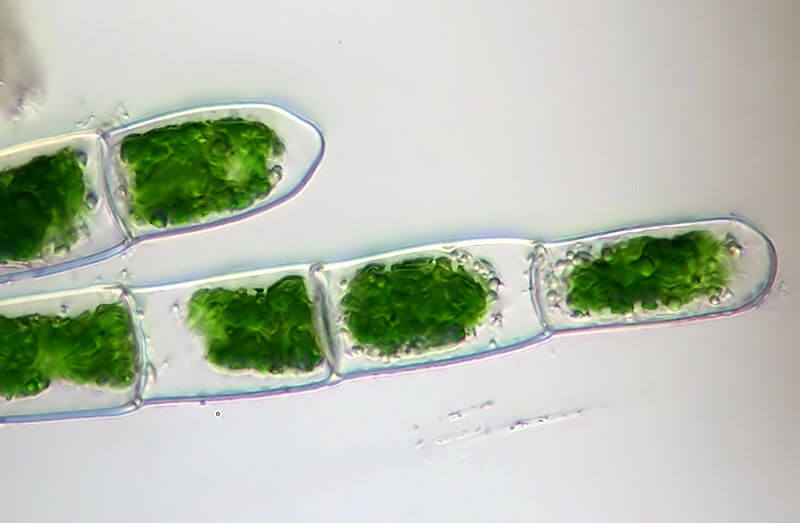
The dangers of algae
Suspended algae can cloud up the water in aquaponic systems, foul pipes and pumps, and cause physical problems. But there are two main problems with algae that especially need to be addressed:
1. Oxygen depletion
2. pH swings
Oxygen depletion and fluctuation
Algae cause oxygen problems in two ways.
First, algae can cause drastic dips in oxygen when it’s dark. During the day, algae essentially create their own oxygen by splitting water molecules. As they create oxygen, they’re also consuming CO2 to build sugars.
At night, when photosynthesis ceases, the algae begin to consume oxygen, but cease to produce it. This can lead to oxygen depletion in the dark. Oxygen levels would stay level during the day but plummet at night.
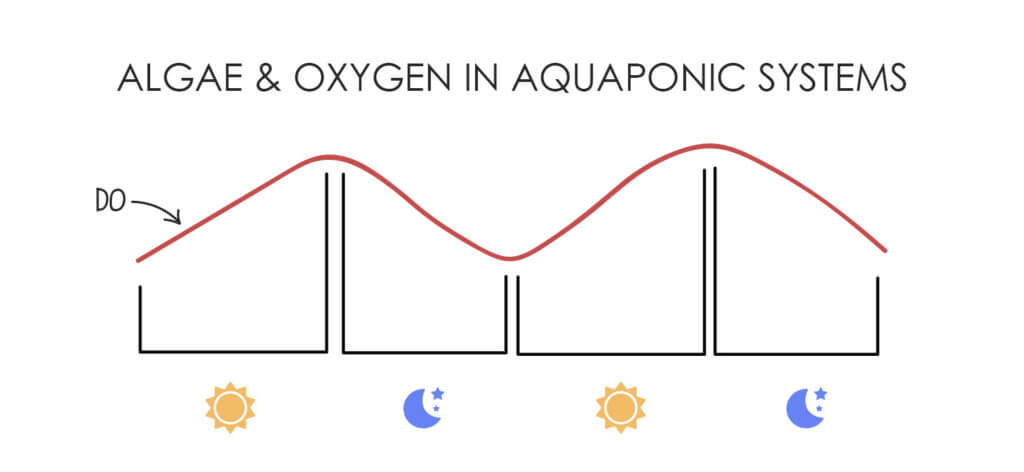
This fluctuation can make identifying algal problems difficult.
For example, a farmer measuring dissolved oxygen (DO) in the middle of an algae bloom can be very confused. They might notice that their fish are stressed or dying, but all system variables look fine, even DO, which they measure late in the morning or afternoon.
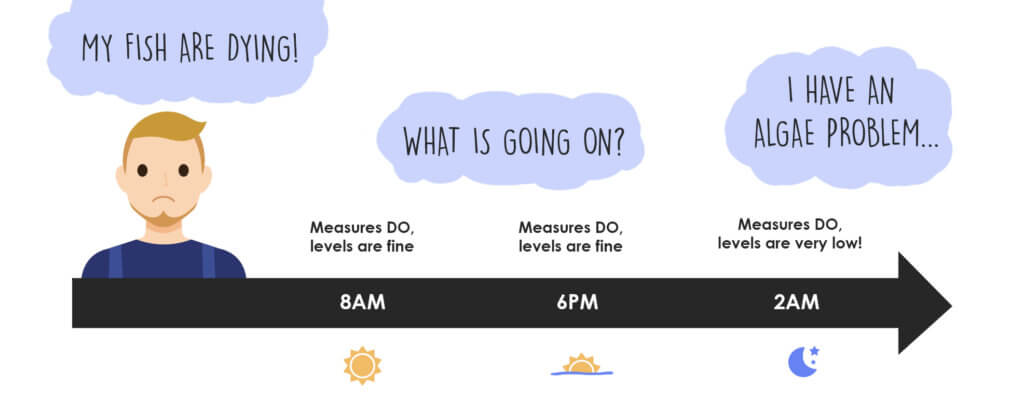
However, if they sneak out at 2 or 3 in the morning to measure DO, they might discover the source of all of those stress symptoms—DO depletion due to too many algae consuming too much oxygen in the dark.
Algal decomposition
Oxygen consumption happens when dead algae begin to decompose. This isn’t usually an issue if it happens in grow beds or other aerobic environments. It really is an issue when it happens in the fish tanks or other aquatic environments.
Decomposition consumes a lot of oxygen, so when the decomposition of algae (or any other organic waste for that matter) happens beneath the surface of the water, often oxygen is consumed faster than it can be replenished. When this happens, all of the aerobic organisms in the system suffer, including bacteria, fish, and plants.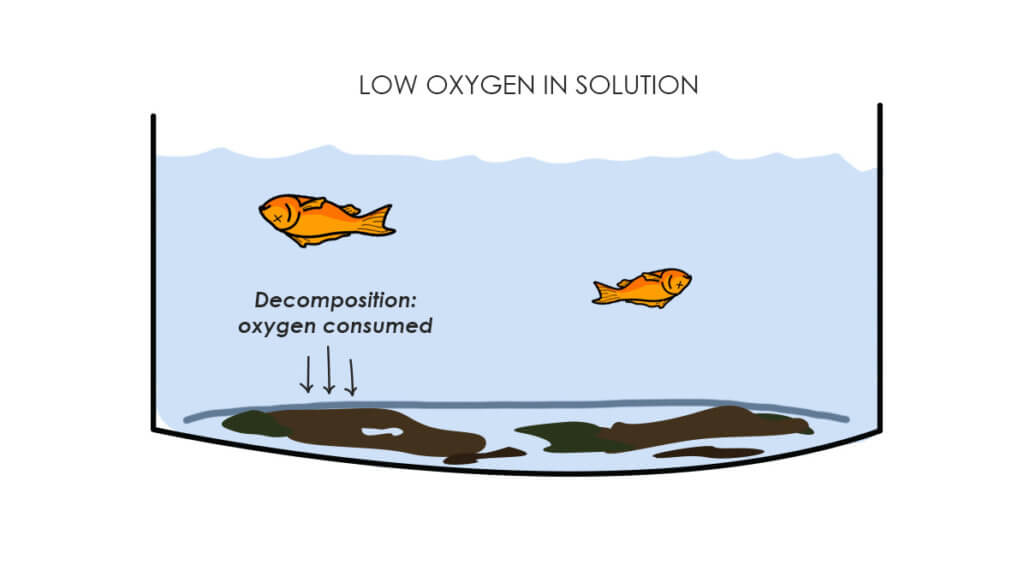
For this reason, accumulating algae should be removed from the system as it begins to die off, or minimally, more aeration should be provided to the system as algae blooms begin to die off (either through aeration or circulation).
The pH problem
Algae can cause pH swings that negatively affect system health and confuse beginning aquaponic practitioners. These swings are called diurnal pH swings.
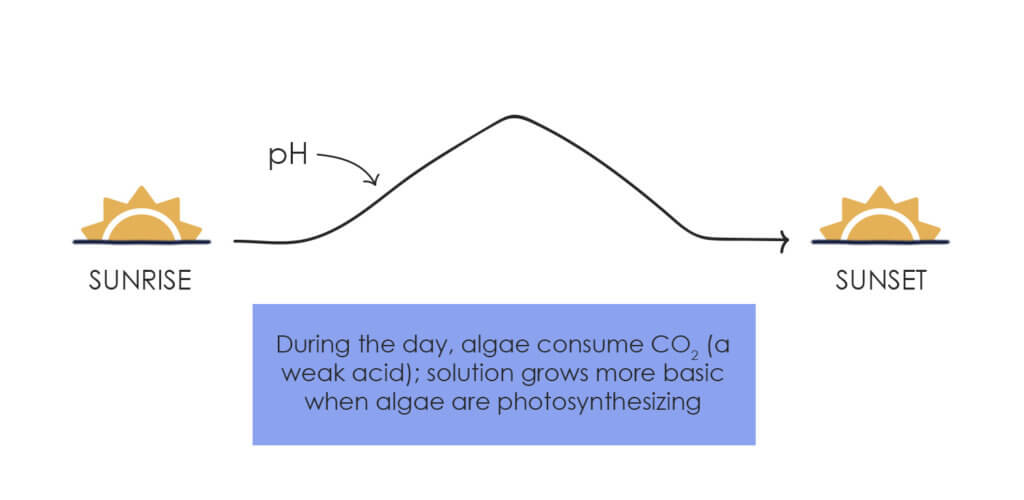
Algae cause pH swings because they consume CO2 during the day when the sun is high and photosynthesis is at its peak. CO2 is a weak acid in your system solution, so as the algae remove it from the water, the water pH will rise, oftentimes as much as a point or two!
This can be very confusing for the beginning grower as pH may be low in the morning and shoot up in the late morning and afternoon, only to drop again late in the evening. If you don’t understand that the algae in your system are causing the problem, it seems like your system chemistry is going crazy!
The simple answer to solving diurnal pH swings caused by algae is to have fewer algae. To reduce algae, there are several preventative and active measures you can take.
Combating algae in aquaponics
Before you do anything crazy, follow best practices to prevent algae. These are the low-hanging fruit that you should be doing anyway!
- Make sure temperature range is appropriate for the crops and fish.
- Measure phosphorous to make sure that it’s not too high.
If you’re still having algae trouble, it’s time go on the offensive and deal with it. The two easiest methods are mechanical filtration and shading. (We’ll also let you in on a special trick of using humic acid additions to shade the water.)
Like any pest control, growers should use a combination of controls to effectively manage their system.
1) Shading:
Shading is the easiest method to reduce algae in your systems. Green algae need light to grow and reproduce, so to get rid of them easily, simply shade your fish tanks with a dark colored tarp or piece of plastic.
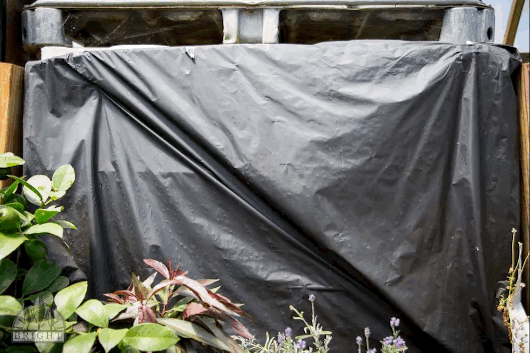
Many growers will also paint the white (transparent) sump tank black (barrels and IBCs) or do a layer of black paint and then white (to prevent the water from heating up), to prevent algae accumulation on the inside of the plastic.
Similarly, if you struggle with algae accumulation on the surface of your media bed or Bato buckets, shade the surface by adding enough rock or gravel that the surface of the water is covered. Shading denies green algae the light it needs to survive, and will dramatically reduce a system’s problems with algae.
2) Mechanical filtration:
In many systems, mechanical filtration plays a big role in algae removal. Oftentimes this equipment is very expensive, but it can sometimes be made inexpensively. This type of equipment includes filters, screens, vortex and centrifugal settlement equipment, settlement tanks and other mechanical means of removing algae from the solution.
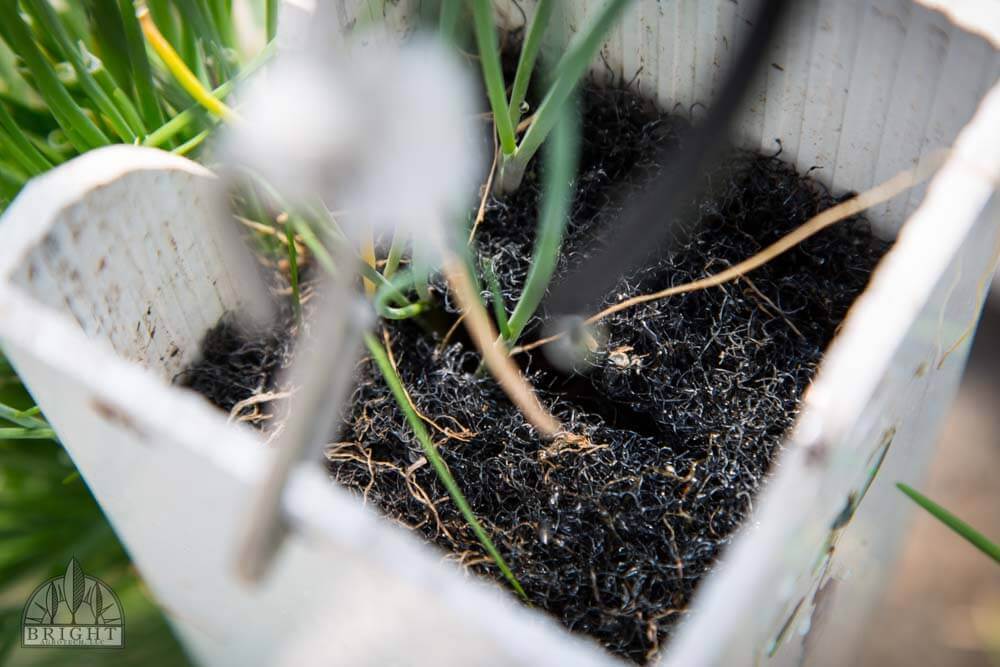
In our greenhouses, we use ZipGrow Towers, which act as a massive mechanical filter, physically capturing and removing algae from the system.
This is another great method for removing algae, and many systems employ physical removal whether they realize it or not. If you have a grow bed on your system, it functions as a mechanical filter, straining algae out of solution.
3) Other techniques [a trade secret]:
There are many other techniques, including the use of Ultra Violet clarifiers, barley straw, etc., but one of my favorite techniques is the use of humic acid to “darken” your system water.
In very shallow water, adding humic acid to a system can actually stimulate algal growth, but in deeper waters, the use of humic acid darkens the water and shades out the depths of the tank.
Humic acid is a great addition to your system whether or not you have issues with algae. It’s great for your fish and your plants and can help chelate a number of important plant nutrients. The shading effect it exacts on algae in deep systems is really just a bonus.
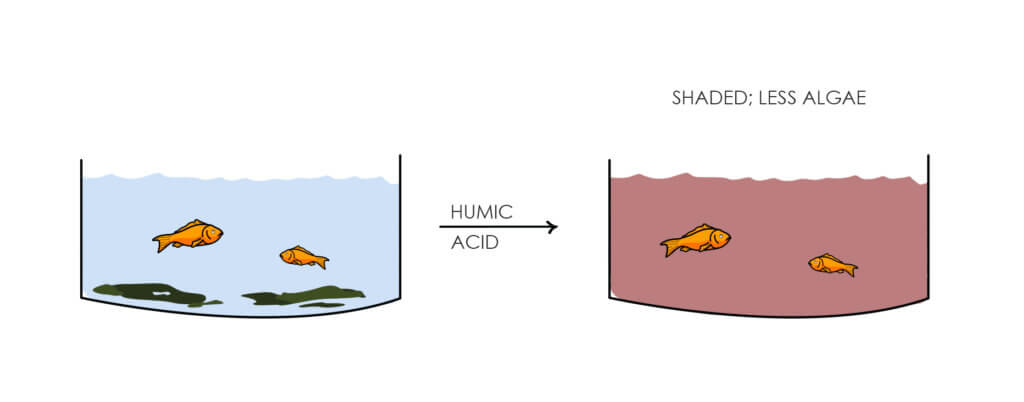
Some of the other techniques out there are worth exploring but are oftentimes too messy and expensive to justify.
The ultimate algae treatment:
In the end, the best treatment is a combination of shading and filtration combined with patience. Algal blooms are an important part of any system establishment.
“When you build a system, you’re really constructing an ecology, and with that ecology comes a break-in period, where new organisms are colonizing the system, fighting for control and finally reaching a steady state—establishing a stable population.”
Algae is great at colonizing, and will always be an important part of nutrient cycling in any system, but it seldom causes serious problems in the long run. Give it enough time, and it will eventually die back and find a balance.
So be patient, and see what happens. The hardest part of establishing any aquaponic system is waiting! Shade, filter, and wait, and your algae problems will eventually disappear.
Algae in hydroponics
Algae rarely become a problem in hydroponic systems, which are less biologically active and have less space for algae populations to thrive. This means that there are typically fewer ways for algae to enter the system. If algae do enter the system, there is less space for them to populate.
For hydroponic growers, controlling algae is much easier. Growers have two main options:
Shading: Like in aquaponics, shading algae will starve them of light.
UV filters (clarifiers): UV filters consist of a plastic or steel cylinder with a lamp housed inside. In that lamp is a filament that produces UV light. This light sterilizes the water flowing around it, destroying bacteria and algae. UV filters are an easy way to control algae and can be a great help to health and sanitation in the system as well.
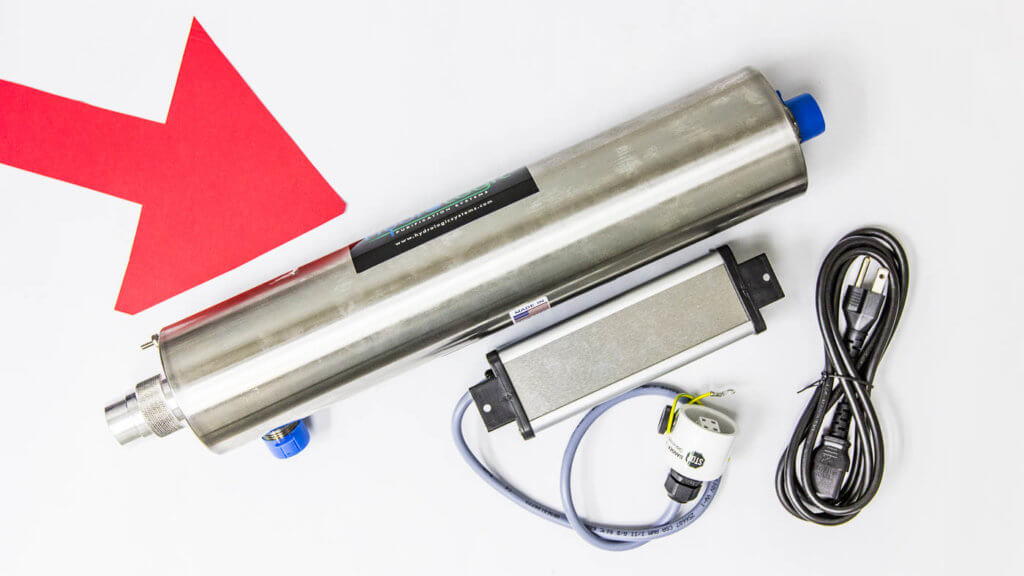
Check out how UV filters are used in the ZipFarm filtration manifold.
Learn more about dodging aquaponic problems
Want to be a great aquaponic farmer? Dive deep into the Foundations of Aquaponics course here at Upstart University to learn about: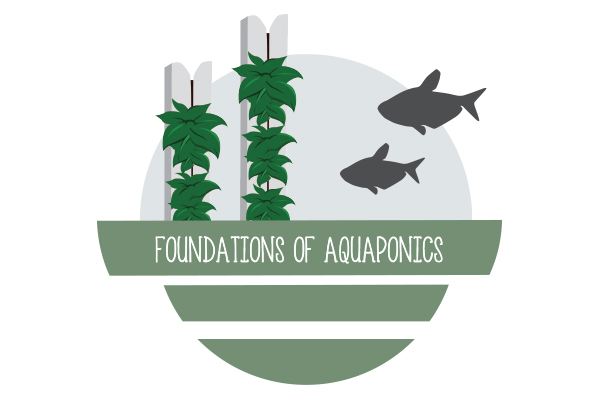
- Applications of aquaponics
- Interactions in the system
- Managing system biology
- Designing and starting a system
- What to do when things go wrong
- Aquaponics myths
- The future of aquaponics



There is a third solution.
IT eliminates algae and adds dissolved oxygen
see:
http://www.matrixenvironnement.com/About-greenhouses.html#googtrans(en|TARGET_LANG_CODE)
if i want to actually grow algae in an aquaponic system for educational purposes can you give me any ideas how to do it?
Hi,
Does it make sense to fight against algae by increasing solution temperature up to 50C during watering standby time? not every day , just in regular schedule e.g once a month or week.
Surely it will deoxygenate the solution and may(may not) change EC parameters. However if you do it in regular manner it looks less dificult. Of course care shall be taken to cool it down and wait before next irrigation cycle.
Are the tomatoes safe to eat if Hydroponic tank has green algae ?
Hi John! Yes, they’re fine 🙂
How are they ok there would be algae in it.
When the water level is low and high, it will affect the Ph level?
Hi there—
Yes, it certainly can. Adding water to a high level will dilute the solution and affect pH depending on what the pH of the water added is. pH can also drift as water gets low since nutrients often become more concentrated at low water levels and nutrients tend to be acidic. pH also tends to drift slightly upward over time with most common hydroponic nutrients because the nutrients tend to make the plant root zone produce chemical compounds with a high pH. These effects are always more pronounced with smaller reservoir sizes.
I only have algae in my transfer tubes. I have a out 60litres of water. Can I add a little janola.
How much humic acid do you add and do you add it directly to the pond or into the pond sump (filtration systems)? Thanks!